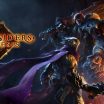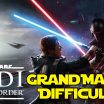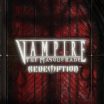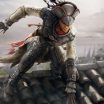Nostalgia Fever: Dark Cloud

Last week I talked about a game that has so much stuff to do its easy to lose track of time. But Dark Cloud 2 didn’t become successful on its own, hence the name (its original title over in Japan and Europe releases is really Dark Chronicle, but that’s another story). A lot of what makes Dark Cloud 2 fun is only because the first Dark Cloud made it so. But does Level 5’s original game, as well as their first game released, hold up to the sequel in its roots? This is what I’m writing to find out.
The story of Dark Cloud is a bit more serious and dark; you see an ancient evil called the Dark Genie resurrected from its sealed urn, and the first thing it does is eat one of the guys that made it possible. Then it goes to the hero’s home town, in the middle of a festival, and blasts it to oblivion before doing the same to every town/city in the world. However, all is not lost. The Fairy King manages to save everyone by sealing them into Atla stones before throwing them into the closest dungeons. He then bestows the hero, Toan, an Atlamillia stone to his wrist to open them up and recreate his city the same as (or even better than) before. After his town is brought back to normal, he goes on a journey to do the same for the rest of the world and find a way to beat the Dark Genie.
Now, as a much older game (made back in 2000), it’s very much different from games of today on the new consoles like PS4. Unlike the sequel that came out two years later, there’s no voice acting. The 3D graphics would look amateurish to some as they aren’t as detailed. The music is decent, though I do recall a good song or two I really liked, such as the one that played during the intro movie. In a nutshell, this game might not appeal for those looking for high quality.
Compared to Dark Cloud 2, the gameplay in Dark Cloud is harder, yet easier in some cases. The main reason is because Dark Cloud requires you to really be aware of your survival and status of everything. Weapons can break, you can die of thirst, monsters can kill you, and you may run out of items that can prevent bad things. While there’s no standard game over, you still lose half your money when dying in a dungeon, which is just as bad.
This game also rewards players who are daring. There are special stages that can be accessed by using an item at a hotspot, like train oil for a mine cart in the first dungeon. The monsters over there glow yellow, are MUCH stronger and can kill you if you’re not careful. On the flip side, items gained there are usually rare and potent items like diamonds or rubies, which are both good to sell and much more powerful than standard crystals to synthesize into weapons.
On the flipside, this is a hardcore dungeon crawler game that only allows for a few distractions like fishing and town recreating. In the sequel, as I mentioned last week, there were a LOT of mini-games and stuff to do from fishing to photographing to even time-distortion golfing that the game was more about having fun than saving the world. Dark Cloud lets you have fun too, but only as so long as you remember you need to save the world, such as avenging a fallen character’s death by killing the Killer Snake.
Weapon use is different between the two games, but the basic idea is the same. When you use a weapon to kill an enemy, you get experience points to level it up. Each time a weapon levels up, you can synthesize items (usually crystals) to increase its stats and then, when the stats are high enough, you can evolve the weapon to a stronger form. In Dark Cloud 2, you had two characters each with a melee and ranged weapon, but Dark Cloud, you had 6 characters with only one weapon and each with a specific focus (3 for melee, 3 for ranged). Weapon managing is a bit more complicated in the first game because there are a lot more stats and numbers to consider ranking up, such as how strong they are against killing a certain monster type (Dark Cloud 2 either completely dropped this or simplified it into a few select stat numbers like “Smash” or “Beast”). Also, you need to make sure to use repair powder whenever your weapon’s durability stat reaches zero, because if not, your weapon will break and be lost forever. This was dropped in the sequel, though.
I like this game a bit better because you can actually see the destruction your enemy throws at you instead of being told first hand after it was over. True, the characters you meet both in towns and your party are a bit bland and hardly resolved in their own towns, but its a small miss. To be truthful, both Dark Cloud games should be played for the fun weapon system (and distracting mini-games if you’re up for that) than digesting the story behind them.










Leave a Reply